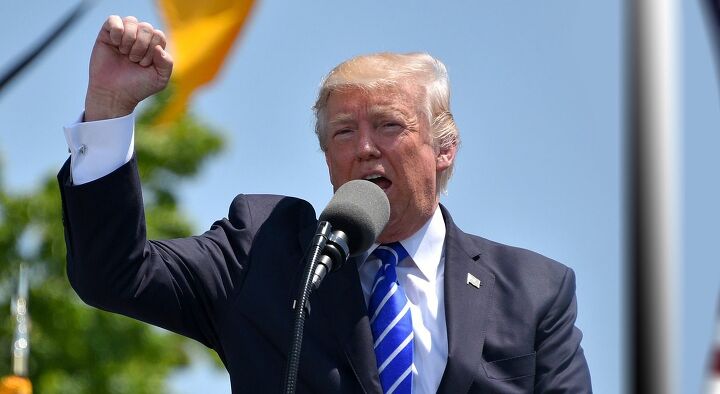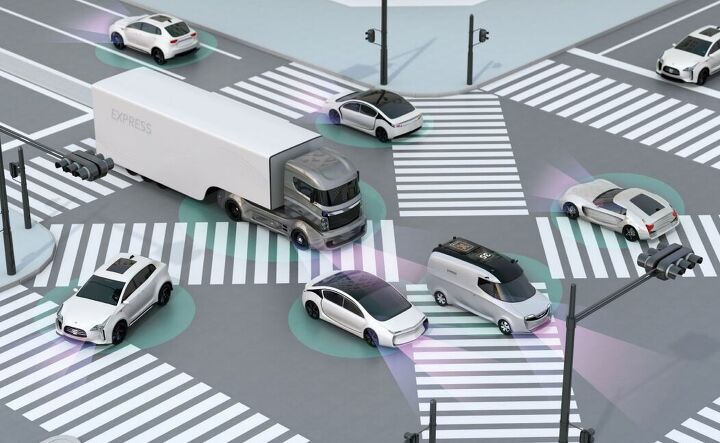#dot
Drowsy Driving Might Be a Bigger Problem Than Previously Thought
Back in 2014, an American Automobile Association study estimated that tired motorists were responsible for around 328,000 accidents annually — 6,400 of which were fatal. However, unlike drunk driving, there’s no sound metric for assessing the true scope of the problem. Getting tired is something that just sort of happens. People don’t stay out all night not sleeping because it’s fun, the police can’t test for it, and almost nobody is going to say they were dozing off behind the wheel in an accident report — either because they are too embarrassed or stopped feeling tired at the moment of their brush with death.
That makes the issue a bit of a phantom menace. We all know it’s a problem, but the frequency remains debatable. Fortunately, a new study released by AAA this week helps clear things up. Researchers affixed dashboard cameras to 3,593 vehicles in order to monitor the drivers’ faces, then used a PERCLOS-based fatigue monitoring strategy to come to the conclusion that drowsiness is a contributing factor in 10.6 to 10.8 percent of all accidents resulting in significant property damage, airbag deployment, or injury.
Proposed Legislation Would Make It Easier for Automakers to Meet Efficiency Requirements
A bipartisan pair of congressional representatives from Michigan are proposing a new bill, the Fuel Economy Harmonization Act, that would aid automakers in complying with federal fuel efficiency requirements. Introduced on Wednesday, the bill would extend the life of fuel economy credits that are set to expire in five years and raise the ceiling on transferrable credits between car and truck fleets. Under the proposal, manufacturers could also be given additional credits for lowering fleet-wide emissions under new metrics.
Penning the bill, congresspersons Fred Upton (Republican) and Debbie Dingell (Democrat) said they believed the automotive industry would benefit from having a single set of fuel rules. The bill suggests rolling the NHTSA’s Corporate Average Fuel Economy (CAFE) and the EPA’s light-duty vehicle Greenhouse Gas Emissions mandates into one cohesive program.
While economy mandates have been growing, nationwide fuel consumption has still gone up. Likewise, the average mpg of cars sold in the United States hasn’t changed much over the last three years. With pump prices remaining low, consumers have flocked to less-efficient models like crossovers and SUVs.
NHTSA Appoints New Deputy Administrator, Still No Department Head
Last week, we discussed how the National Highway Traffic Safety Administration had some staffing gaps that needed shoring up. While it remains shy one administrative head, the White House saw fit to officially appoint a new deputy administrator — effectively replacing acting deputy administrator Jack Danielson’s interim leadership.
Danielson has served as the NHTSA’s executive director since 2015, but spent the last eight months filling in for an absent department figurehead. He’s being relieved by Heidi King, an economist with the federal government and experience in the private-sector.
You Not Having a Car With 'Superpowers' is Somehow Donald Trump's Fault
Supposedly, everyone eagerly anticipates the day they can own a shiny-new self-driving car, but automakers, regulatory agencies, consumer advocates, Silicon Valley, and the White House are debating how exactly that’s supposed to happen. They haven’t reached a consensus yet — and that’s probably not likely to change anytime soon.
Most autonomous cars rely on array of cameras, LIDAR, GPS, inertial measurement devices, and complex control systems used to interpret sensory information before reacting accordingly. Vehicle-to-vehicle communication systems (V2V) are regarded by many as essential components to establishing fully automated travel. The theory is that, by allowing cars to communicate directly on a broadband frequency, they can better predict each other’s movements.
However, a recent Bloomberg article accuses the technology of “going nowhere fast,” citing the Trump administration as the chief culprit, and alluding to the direct stifling of technology that would give cars “superpowers” in the next few years.
I probably won’t have the opportunity to say this often — and it feels kind of strange to say it now — but these accusations aren’t entirely fair to the president or his administration.
NHTSA's Updated Autonomous Safety Guidance Doesn't Actually Offer Any
On Tuesday, Transportation Secretary Elaine Chao outlined the Trump administration’s “Vision for Safety 2.0” at the University of Michigan’s Transportation Research Institute in Ann Arbor. The document is a collection of non-binding requests to manufacturers and a promise that they can go hog-wild with their autonomous vehicle testing, at least as far as the feds are concerned.
In a deluge of policy updates, the National Highway Traffic Safety Administration tweaked its vision for safety, claiming it was responding to the recent increase in the number of road accidents.
While Obama-era guidelines weren’t particularly robust, the Trump administration has essentially built a technical-sounding framework aimed at destroying regulatory red tape. Ironically, the government seems to have gone out of its way to ensure it stays out of the way. In some respects, it has to. The speed of development is beginning to happen at a rate where any outside bureaucracy would have difficulty keeping pace. Chao said the guidance would remain flexible, ready to adapt to the changes as they come. But it is also without teeth, promoting development and the future promise for safety at the expense of any meaningful oversight.
Did the Department of Transportation and NHTSA sell themselves out to industry or do they actually think giving automakers carte blanche on autonomous testing was the best thing for public safety?
Give the U.S. Government a Piece of Your Mind About Fuel Economy Rules
While the Trump administration continues gearing itself up to loosen fuel standards for automakers, much to the chagrin of environmentalists and other countries, the agencies that set those benchmarks want to pick your brain a little before making a final decision. You’ve got an opportunity to be part of the process — the painfully boring, yet incredibly important, process.
On Thursday, the U.S. Environmental Protection Agency and the Department of Transportation opened a public comment period on the reconsideration of the standards for greenhouse gas emissions for light vehicles built for the 2022-2025 model years. Additionally, the EPA wants comments on the appropriateness of the existing 2021 standards. The agencies are inviting the public to submit any relevant (i.e. factual) data and information that can inform a final decision of the standards.
Piston Slap: Crystal Clear Thoughts on Headlight Upgrades
TTAC Commentator flipper35 writes:
I have a 2000 Dodge Durango ( wrote about the brakes on it before, all is good with them) and the lights are not the greatest. After replacing the passenger side due to a deer ramming its butt into it, its headlights no longer match. I’ve looked on several Mopar forums and there doesn’t seem to be any consensus on which lights are good — but they can all agree on what is crap.
So, I am willing to spend $300 on a proper headlight upgrade if that’s what it takes. I see a few conversions where you bake the headlights at low temp to release the glue and then put bi-xenon with the flappy shield in with the ballasts and wiring kit. They sound reasonable but there are some other projector-style lights out there that would be less work if they are focused and aligned properly. I’m mechanically inclined but with family and other projects I would rather spend less time on these and more time on replacing stuff like the worn grommets on the electric seat adjustment screws and such. (At 190,000 miles, it needs front suspension bushings, too.)
Federal Government Pushes for Speed Limiters on Trucks and Buses
The U.S. Department of Transportation wants to mandate speed-limiting devices on all tractor-trailers and buses in the country in a bid to save lives and fuel.
Announced yesterday by the National Highway Traffic Safety Administration, the proposal would limit vehicles with a gross vehicle weight rating of 26,000 pounds or more to 60, 65, or 68 miles per hour. Other speed limits could be considered, but that’s up to the public to debate.
DOT Goes Wikileaks on Dealers, Puts Your Car's Secrets Online
Your vehicle’s hidden flaws and most shocking (mechanical) secrets will soon be just a click away.
The Department of Transportation is ending the clandestine relationship between your car’s dealer and the manufacturer by posting all Technical Service Bulletins (TSB) online, according to Consumer Reports.
TSBs, which outline the recommended procedure for repairing vehicles, will be posted in PDF form on the safercar.gov website.
A Detroit/Silicon Valley War Is In The Air(waves)
The Alliance of Automobile Manufacturers on Thursday sent a letter to the heads of the Federal Communications Commission, U.S. Department of Transportation and U.S. Department of Commerce, urging the groups to keep dedicated a frequency spectrum for future car communication systems.
The spectrum, which is between 5.850 GHz and 5.925 GHz, was allotted to automakers for car-to-car communication and road-to-car communication. Telecommunications and Wi-Fi industry officials have asked to share the spectrum.
“Um, no,” in the nicest possible way, from the Alliance:
We are committed to finding the best path forward to protect the development and deployment of advanced automotive safety systems while also considering the need for additional unlicensed spectrum to meet the increasing demand for wireless broadband Internet services.
Don't Crush That Bug, Hand Me The Pliers
I’m pretty sure that everyone reading this has interests beyond the world of automobiles. As both an observer of and participant in the news and information biz, it’s fascinating for me to see how a story in the automotive media will sometimes percolate into general news outlets, showing up on the front page, print or digital, of your local newspaper (if it’s still in business) weeks after you’ve read about it here at TTAC or at another car enthusiast or news site.
Obama Nominates Anthony Foxx As Next DOT Head
President Obama announced the nomination of Anthony Foxx, the current mayor of Charlotte, North Carolina, as his choice to succeed Ray LaHood as the next head of the Department of Transportation.
Piston Slap: Of HID-retrofit Hatred, Panther Love…PART II
A TTAC lurker writes:
Sajeev, I’m local to Houston and greatly look forward to my daily lurk on TTAC. I just had to respond affirmatively to the latest piston slap about HID’s and Panthers.Piston Slap: Of HID-retrofit Hatred, Panther Love
Robin writes:
So when I get my next big check I’m getting me a Panther. On this you can depend. You’ve talked me into it! But that’s not the point of my email. Rather, I’ve seen these HID light kits and wonder if it’s a lot of hype or if there is some veracity to the upgrade?
Feds Predict The Future Of The Auto Industry, Foresee Chrysler Freefall, GM Stagnation
Reasonable minds can disagree about the wisdom of the auto bailout, but according to analysis by the EPA and Department of Transportation (based on data from the Department of Energy and auto forecasters CSM), the Government’s rescue of GM and Chrysler may not have been the best idea (at least from a market perspective). According to data buried in the EPA/DOT proposed rule for 2017-2025 fuel economy standards [ PDF here], Fiat-Chrysler is predicted to be the sick man of the auto industry by 2025, losing over half of its 2008 sales volume, while GM is expected to improve by only 3%, the second-worst projected performance (after Aston-Martin). In terms of percentages, even lowly Suzuki and Mitsubishi are projected to grow faster than The Mighty General. Ouch.
On the other hand, the proposed rule notes that data will be finalized before the final rule comes out. Besides, the agencies appropriately admit (in as many words) that projecting auto sales so far into the future is one hell of a crapshoot. Still, with the obvious exception of “Saab-Spyker” and with some skepticism about the projection’s optimism about overall market growth aside, these are not the craziest guesses I could imagine. Who knows what the future holds, but it certainly is a bit troubling that the government’s own data suggests the two automakers it bailed out may well have some of the weaker performances of the next 14 years. At least the Treasury could have sold off their remaining GM stock before this report was released…





























Recent Comments